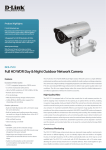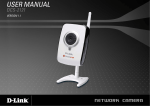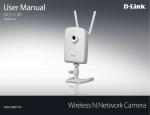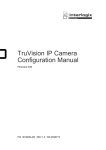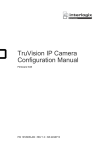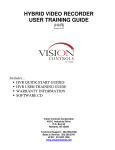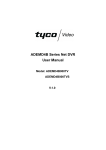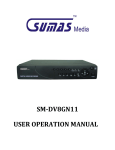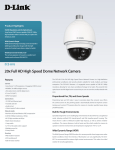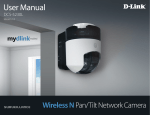Download Using the Setup Wizard - D-Link
Transcript
Table of Contents Table of Contents Product Overview......................................................... 3 Features................................................................... 4 Package Contents.................................................... 5 System Requirements.............................................. 5 Hardware Overview ................................................. 6 Hardware Overview (Connectors)............................ 7 Hardware Installation................................................ 8 Software Installation............................................... 10 Configuration.............................................................. 21 Using the Setup Wizard.......................................... 21 Using the Configuration Menu................................ 25 Web-based Configuration Utility............................. 26 Live Video............................................................... 27 Camera............................................................. 27 Setup...................................................................... 29 Setup Wizard.................................................... 29 Internet Connection Setup Wizard.................... 29 Motion Detection Setup Wizard........................ 33 Network Setup.................................................. 36 Dynamic DNS................................................... 38 Image Setup..................................................... 39 Audio and Video............................................... 40 Motion Detection............................................... 41 Time and Date.................................................. 43 Recording......................................................... 44 Creating a Samba network drive for saving video...46 D-Link DCS-7410 User Manual Snapshot........................................................... 47 Digital Output.................................................... 50 RS-485.............................................................. 51 Maintenance........................................................... 51 Admin................................................................ 51 System.............................................................. 53 Firmware Upgrade............................................ 54 Status..................................................................... 55 Device Info........................................................ 55 Logs.................................................................. 56 Help........................................................................ 57 D-ViewCam Installation.............................................. 58 Adding a Camera.................................................... 61 Troubleshooting......................................................... 66 DI/DO............................................................................ 68 Networking Basics..................................................... 69 Check your IP address........................................... 69 Assigning a Static IP address................................. 70 Technical Specifications........................................... 71 2 Section 1 - Product Overview Product Overview The DCS-7410 is a day & night outdoor PoE network camera with built-in infrared LEDs. Equipped with a high-resolution Sony CCD image sensor, this camera provides you with excellent image quality and level of detail. The DCS-7410 can detect moving objects in total darkness, for distances of up to 30 meters. Embedded with a powerful SoC (System-onChip), the camera provides high-quality, real-time video compression in MPEG-4 and motion JPEG formats. These elements make the DCS-7410 an ideal solution for 24-hour surveillance. The DCS-7410 is housed in an IP66 certified weatherproof casing, which protects the camera against rain and dust. You can also connect the camera to I/O sensors such as IR sensors, switches and alarm relays, and set up the system to send automated e-mail notifications for unusual events. A live feed from the camera can be accessed on a 3G mobile network by using a compatible mobile phone or PDA with a 3G video player. The bundled D-ViewCam software is included to manage up to 32 cameras simultaneously, send automated e-mail alerts, and record video to your hard drive when motion is detected or according to a set schedule. The software allows you to manage and record videos to a Network Attached Storage (NAS) or a Network Video Recorder (NVR) device. Note: Use of audio or video equipment for recording the image or voice of a person without their knowledge and consent is prohibited in certain states or jurisdictions. Nothing herein represents a warranty or representation that the D-Link product provided herein is suitable for the end-user’s intended use under the applicable laws of his or her state. D-Link disclaims any liability whatsoever for any end-user use of the D-Link product, which fails to comply with applicable state, local, or federal laws. D-Link DCS-7410 User Manual 3 Section 1 - Product Overview Features •Supports a variety of Protocols: Supports TCP/IP networking, SMTP e-mail, HTTP, and other Internet related protocols. The DCS-7410 can easily be integrated into Internet/Intranet applications because of its standards-based features. •Remote Snapshots: Save snapshots directly from the Web browser to a local hard drive without installing any software. This Snapshot feature allows you to conveniently capture images from a remote location. •Outdoor Deployment: A built-in 802.3af compliant Power over Ethernet (PoE) port simplifies installation giving users the freedom to place the camera anywhere. •Web Configuration: Using a web browser, an administrator can configure and manage the DCS-7410 directly and can also create and control up to 10 accounts with different settings. • 3G Mobile Surveillance: Access the camera’s live feed by using a compatible mobile phone or PDA with a 3G video player, anywhere within a 3GPP service area. •Bundled D-ViewCam Software: Manage up to 32 cameras simultaneously, send automated e-mail alerts, and record videos to a NAS or NVR device. •Applications: The DCS-7410 makes an ideal solution for detailed remote monitoring for places such as homes, offices, banks, hospitals, child-care centers, amusement parks and other industrial and public monitoring areas. Connect the camera to I/O sensors, and set up the system to receive automated e-mail notification of all unusual events. The camera can also be used for intruder detection (motion-detection mode), capture of still images and video for archiving, and can be used for many more applications. D-Link DCS-7410 User Manual 4 Section 1 - Product Overview Product Overview Package Contents • D-Link DCS-7410 Day & Night Outdoor PoE Network Camera • CAT5 Ethernet Cable • Power Adapter 12V, 1.25A • Quick Installation Guide • User Manual and Software on CD • Camera Bracket If any of the above items are missing, please contact your reseller. Note: Using a power supply with a different voltage rating than the one included with the package may cause damage and will void the warranty for this product. System Requirements •Windows® XP or Vista •At least 256MB of memory (512MB recommended) •An available Ethernet connection •Internet Explorer 6 or higher •VGA card resolution: 800 x 600 or higher •CPU: 1.7GHz or higher (at least a 2.8GHz processor, 512MB memory, and a 32MB video card is required for viewing multiple cameras and recording with the D-ViewCam software) D-Link DCS-7410 User Manual 5 Section 1 - Product Overview Hardware Overview Adjustable Top Shield Weatherproof Casing The camera is housed in an IP66 certified weatherproof casing, which protects it against rain and dust. Shields the camera sensor from direct sunlight while providing air ventilation for the camera. IR LEDs with Condenser IR LEDs enables the camera to detect moving objects in total darkness for distances of up to 50 meters. Camera Bracket Attaches to the camera and mount the camera on the wall. D-Link DCS-7410 User Manual 6 Section 1 - Product Overview Hardware Overview Connectors I/O Connector The DCS-7410 offers a 8 pin-contact terminal block. Two pairs are for input, one pair for output and RS485 terminals. The connector provides a physical interface to send and receive digital signals to and from a variety of external devices. Audio Out Connector Speakers (not included) may be connected to the camera for a 2-way audio communication. DC Power Connector Attach the Power Adapter to the DC connector and connect the power adapter to a power outlet. Ethernet Cable Connector (PoE) Plug the Ethernet cable into the RJ-45 PoE connector. When connected to a PoE switch, the built-in 802.3af compliant Power over Ethernet (PoE) eliminates the need for a nearby power outlet, giving you the freedom to place the camera anywhere. Link/Power LEDs Lights up and changes color to indicate the Link and Power status of your camera. Green LED indicates Link up/Link down/ Traffic Red LED indicates Power on/Power off Reset Button Resets the camera to factory defaults when pressed for 10 seconds. BNC The BNC connector is used for professional video connections. It benefits users who integrate digital IP cameras into a traditional system (CCTV) for both analog and digital video streaming purposes. D-Link DCS-7410 User Manual Microphone Connector Connect an external microphone to the microphone connector to hear what is happening near your camera. 7 Section 2 - Installation Hardware Installation Step1. Attach the camera bracket to the camera using screws (Front point). Step2. Attach the camera bracket to the camera using screws (Back point). D-Link DCS-7410 User Manual 8 Section 2 - Installation Step3. Connect the cables as required. Refer to the Hardware Overview, Connectors section for details on the different connectors D-Link DCS-7410 User Manual 9 Section 2 - Installation Software Installation Insert the Installation DCS-7410 driver CD into your computer’s CD-ROM drive to start the autorun program. The Setup Wizard will guide you through the entire installation process from connecting your hardware to configuring your camera. Click Setup Wizard If the autorun program does not automatically start on your computer, go to Windows, click Start > Run. In the Run command box type D:\DCS7410.exe, where D: represents your CD-ROM drive. D-Link DCS-7410 User Manual 10 Section 2 - Installation After clicking Setup Wizard, the following window will open. Click Next to continue. Click Next Click Yes to accept the License Agreement. Click Yes D-Link DCS-7410 User Manual 11 Section 2 - Installation To start the installation process click Next. Note: The installation may take several minutes to finish. Click Next D-Link DCS-7410 User Manual 12 Section 2 - Installation Click Finish to complete the installation. Click Finish D-Link DCS-7410 User Manual 13 Section 2 - Installation Click ffdshow from the autorun screen to install the proper codecs that will allow you to playback videos taken by the DCS-7410. Click ffdshow Click I Agree D-Link DCS-7410 User Manual 14 Section 2 - Installation Select Language, and then click OK Click OK Select Language, and then click OK Click Next D-Link DCS-7410 User Manual 15 Section 2 - Installation Click Next Click Next D-Link DCS-7410 User Manual 16 Section 2 - Installation Click Next Click Next D-Link DCS-7410 User Manual 17 Section 2 - Installation Click Next Click Next D-Link DCS-7410 User Manual 18 Section 2 - Installation Select the speaker from your PC, and then clink Next Click Next Click Install D-Link DCS-7410 User Manual 19 Section 2 - Installation Installing Click Finish D-Link DCS-7410 User Manual 20 Section 3 - Configuration Configuration This section will help you configure your new D-Link Network Camera using the Setup Wizard. Using the Setup Wizard Click the D-Link Setup Wizard SE icon that was created in your Windows Start menu. Click D-Link Setup Wizard SE D-Link DCS-7410 User Manual 21 Section 3 - Configuration The Setup Wizard will display the MAC address of the DCS-7410 and an IP Address (which may or may not be correct depending on your DCS-7410 connection). If you have a DHCP server on your network, there will be a valid IP Address displayed here. Click the Wizard button to continue. Enter the admin ID and password. Note: The default Admin ID is admin with the password left blank. Click Next D-Link DCS-7410 User Manual 22 Section 3 - Configuration Select DHCP if you want to get an IP address automatically from your router or Internet service. Click Next to continue. Click Next Alternatively, you can select Static IP to use the same IP address on camera start up. Click Next to continue. Click Next D-Link DCS-7410 User Manual 23 Section 3 - Configuration Click Restart to save your settings and reboot your Network Camera. Click Restart Click Link to access the web configuration page. The Setup Wizard will automatically open your web browser and enter the IP address of your camera into a web browser. In this example, the IP address is http://192.168.1.185. Your DCS-7410 may have a different IP address. Click Link D-Link DCS-7410 User Manual 24 Section 3 - Configuration Using the Configuration Menu After completing the Camera Installation Wizard, you are ready to use your camera. The camera’s built-in Web configuration utility is designed to allow you to easily access and configure your DCS-7410. At the end of the Setup Wizard, click Go To Camera, or enter the IP address of your camera into a web browser, such as Internet Explorer. To log in, use the User name admin and the password you created in the Installation Wizard. If you did not create a password, leave the password text box blank. After entering your password, click OK. Note: If you are directly connecting your PC to the camera, or if you are using the camera on a closed network, the default IP is 192.168.0.20. Click OK D-Link DCS-7410 User Manual 25 Section 3 - Configuration Web-based Configuration Utility Use the following sections to set up and configure your network camera: •LIVE VIDEO •SETUP •MAINTENANCE •STATUS •HELP D-Link DCS-7410 User Manual 26 Section 3 - Configuration Live Video LIVE VIDEO > Camera This section shows your camera’s live video and event indicators. You can zoom in and out of the live video image using your mouse. Left-click to zoom in and right-click to zoom out on the image. You may also select your language setting using the drop-down menu. Digital Input This indicator will light up, when there is an available digital input signal. Motion Trigger This indicator will light up, when an event is triggered. Note: Ensure that the video motion feature of your camera is enabled. Recording This indicator will light up, when a recording is in progress. D-Link DCS-7410 User Manual 27 Section 3 - Configuration You can access various functions by clicking on the buttons at the bottom of the window: Video Profile: There are four different viewing profiles, which you can configure in Setup > Audio and Video. Full Screen: This allows you to view the video in full screen mode. To exit full screen mode, press the ESC key on your keyboard. Snapshot: Click to capture a snapshot image. The image will pop up in a new window. You may save this image to a local hard drive. Record Video: Clicking this button will start or stop recording video to the file path specified with the Set Storage Folder button. Set Storage Folder: You can change the folder where the video recordings will be saved. Start/Stop Audio: This button toggles the microphone on and off, allowing you to hear audio from the area surrounding your camera. Start/Stop Talking: This button toggles the speaker on and off, allowing you to talk with others near your camera. Start/Stop Digital Output: This will toggle the GP DO output on and off. D-Link DCS-7410 User Manual 28 Section 3 - Configuration Setup SETUP > Setup Wizard The setup wizard guides you through the initial setup of your IP camera. You can use the Internet Connection Setup Wizard for initial network setup, and you can use the Motion Detection Setup Wizard to set up motion detection and snapshots. Simply follow the instructions given in each step of the wizard to quickly set up your camera. Alternatively, you can manually set up your Internet connection by clicking Manual Internet Connection Setup, and you can manually set up motion detection options by clicking on Manual Motion Detection Setup. You can also see these settings by clicking on the menu on the left panel (Network Setup / Motion Detection / Snapshot). Internet Connection Setup Wizard This wizard will guide you through a step-by-step process to configure your LAN and Internet configuration. Click Next to continue. Click Next D-Link DCS-7410 User Manual 29 Section 3 - Configuration Select DHCP if you are not sure which LAN settings to use. This allows your camera to get an IP address automatically from your router or Internet service. Click Next Select Static IP to manually set the IP address information of your camera. Click Next D-Link DCS-7410 User Manual 30 Section 3 - Configuration If you are using a PPPoE connection, check Enabled and enter the Username and Password for your PPPoE account. You can get this information from your Internet service provider (ISP). Click Next If you have a Dynamic DNS account and would like the camera to update your IP address automatically, select Enable and enter your host information. Click Next Enter a name for your camera and click Next to continue. Click Next D-Link DCS-7410 User Manual 31 Section 3 - Configuration Configure the time to ensure that all events are triggered, captured and scheduled at the right time. Click Next to continue. Click Next If you selected DHCP mode, you will see the following screen appear. Please note down this information in order to access your camera on the network. Click Apply to save your settings. Click Apply If you selected Static IP mode, you will see the following screen appear. Please note down this information in order to access your camera on the network. Click Apply to save your settings. Click Apply D-Link DCS-7410 User Manual 32 Section 3 - Configuration Motion Detection Setup Wizard This wizard will guide you through a step-by-step process to set up Motion Detection on your IP camera. Click Next to continue. Click Next This step allows you to enable or disable video motion and control the sensitivity of your camera. To draw a motion detection zone, select Draw motion area, then click and drag your mouse over the areas of the image you want to monitor for motion detection. You can select Erase motion area to remove areas, and you can also enter a Sensitivity for motion detection, where 0% is the least sensitive setting and 100% is the most sensitive setting. Click Next to continue. Click Next D-Link DCS-7410 User Manual 33 Section 3 - Configuration This step allows you to specify how event notifications are sent from your camera, either through e-mail or FTP. Make sure you enter all the relevant information for your e-mail account or FTP server. Click Next to continue. Click Next D-Link DCS-7410 User Manual 34 Section 3 - Configuration You have completed the Motion Detection Wizard. Click Apply to activate your settings. Click Apply D-Link DCS-7410 User Manual 35 Section 3 - Configuration SETUP > Network Setup Network Setup allows you to configure your LAN and Internet settings. DHCP: Select this to allow your camera to get an IP address automatically from your router or Internet service. If you are not sure which LAN settings to use, try using DHCP mode first. Connection: Select this to manually set the IP address information for your camera. Static IP Address: Enter the IP address the camera should use. IP Address: The fixed IP address. Subnet Mask: Enter the subnet mask that the camera should use. The default value is “255.255.255.0. This option is used to determine if the destination is in the same subnet. Default Gateway: Enter the default gateway that the camera should use. The gateway is used to forward frames to destinations in a different subnet. Invalid gateway settings may cause transmission failure. Primary DNS: Enter the IP address of the primary DNS server that the camera should use. The primary DNS translates domain names to IP addresses. Secondary DNS: Enter the IP address of the secondary DNS server that the camera should use. The secondary DNS is used as a backup for the primary server. Note: If you need to use a static IP address and you do not know the network information, contact your Internet Service Provider (ISP) for assistance. D-Link DCS-7410 User Manual 36 Section 3 - Configuration Enable UPnP: Universal Plug & Play (UPnP) allows Windows PCs to find this camera under “Network Neighborhood” without configuration. Enable UPnP port Enables your camera to add port forwarding entries into the router forwarding: automatically. Enable PPPoE: Select this option if you are using a PPPoE service and enter the User Name and Password for your PPPoE account. You can get this information from your Internet service provider (ISP). HTTP port: This is the port that allows the user to connect to the camera’s user interface. By default the port is set to 80. You may change the port number if using multiple cameras. RTSP port: This is the port that you use for RTSP streaming to mobile devices or PDAs. By default the port is set to 554. You may change the port number if using multiple cameras. Click Save Settings to save your changes, or click Don’t Save Settings to discard your changes. Note: Make sure you set up your router/gateway for Port Forwarding/Mapping; this will enable remote viewing of your camera via the Internet. Please refer to your router’s instruction manual on how to forward ports. D-Link DCS-7410 User Manual 37 Section 3 - Configuration SETUP > Dynamic DNS If you have a DSL or Cable service provider that changes your modem IP address periodically, Dynamic DNS (Domain Name System - a method of keeping a domain name linked to a dynamic IP address) is useful. With the DCS-7410, you can set up your DDNS service and the camera will automatically update your DDNS server every time it receives a different IP address. Depending on the service, this update may take up to a few hours. Enable DDNS: Select to enable the DDNS function of the camera. Server Address: Select a DDNS service provider from the drop-down box or manually enter your server address. Host Name: Enter the Host Name of the DDNS service. User name: Enter your User Name for the DDNS service. Password: Enter the password for the DDNS service. Verify Re type the password for the DDNS service. Password: Timeout: This sets the number of hours between DDNS updates. Status: Indicates the current connection status of your camera to your DDNS service. Click Save Settings to save your changes, or click Don’t Save Settings to discard your changes. D-Link DCS-7410 User Manual 38 Section 3 - Configuration SETUP > Image Setup Image Setup allows you to adjust the settings for your video image. A preview of this image will be shown in the live video window in the middle of the screen. Brightness: This adjusts the brightness of the camera image. Saturation: This adjusts the color saturation of the camera image. Contrast: This adjusts the contrast of the camera image. Hue: This adjusts the color tone of the camera image. Click Reset to Default to reset your settings. D-Link DCS-7410 User Manual 39 Section 3 - Configuration SETUP > Audio and Video Audio and Video allows you to configure four video profiles with different settings for your camera. You may also set up different profiles for your computer and mobile display. In addition, you may configure the audio (speakers and microphone) settings for your camera. Encode Type: This sets the video codec used for the video stream. You can choose MPEG-4 or MJPEG (JPEG). Internet Explorer browsers can view both MPEG-4 and MJPEG video streams, and non-IE browsers can only view MJPEG video streams. Resolution: This sets the display resolution of the video stream. The following options are: • QQVGA@176x120 - Usually set for handheld devices. • QVGA 352x240 - Standard setting for viewing from mobile phones and PDAs. • VGA@704x480 - Standard setting for viewing from a PC. FPS: This sets the target number of Frames Per Second (FPS) for the video stream. Higher frame rates will provide smoother video. BPS: This sets the target bitrate of the video stream. Higher bitrates will provide better quality video. JPEG Quality: This sets the JPEG quality of any manual snapshots you take when this video profile is selected. D-Link DCS-7410 User Manual 40 Section 3 - Configuration RTSP URL: This setting allows you to set a suffix for your camera’s RTSP URL so you can view your camera’s video with this video profile’s settings. For example, if you enter “mpeg4” as your RTSP URL setting and your camera’s IP is 192.160.0.20, you can view your camera’s video with these settings through 192.160.0.20/mpeg4. Enable Speaker: Checking this box will enable you to send audio to an external speaker (not included) attached to the external speaker jack of your camera. This will allow you to speak with another person through your camera. Volume: This sets the volume level of the external speaker. Enable Checking this box will enable you to listen to audio Microphone: picked up by the microphone. This will allow you to hear what is happening near your camera. Volume: This sets the volume level of the incoming audio. Note: Higher frame size, frame rate and bit rates will give you better video quality, but they will also require more network bandwidth. For best viewing results on a mobile phone, we suggest setting the Frame Rate to 5 fps and bps to 20 Kbps. Click the Save Settings to save your changes, or click Don’t Save Settings to discard your changes. D-Link DCS-7410 User Manual 41 Section 3 - Configuration SETUP > Motion Detection This option allows you to set up Motion Detection on your IP camera. In order to use motion detection, you must first check the Enable Video Motion checkbox. You can then click on the video window and draw motion detection zones by clicking and dragging your mouse. Red areas indicate areas that will be monitored for motion. Enable Video Select to turn on the motion detection feature of Motion: your camera. Sensitivity: This setting adjusts how sensitive the camera will be to motion, where 100% will be the most sensitive setting and 0% will be the least sensitive setting. Draw motion Select to draw motion detection area by dragging area: your mouse in the window ( as indicated by the red box). Erase motion Select to erase your motion detection area by area: dragging your mouse in the window. Clear: Click this button to clear all motion detection areas. Click Save Settings to save your changes, or click Don’t Save Settings to discard your changes. D-Link DCS-7410 User Manual 42 Section 3 - Configuration SETUP > Time and Date Time and Date allows you to configure, update and maintain the internal system clock for your camera. You can manually set your time zone from the drop-down box or automatically synchronize your time using Network Time Protocol (NTP) server. Time Zone: Select your time zone from the drop-down menu. Enable Daylight Select to enable daylight saving time. Saving: Auto Daylight This option allows your camera to automatically Saving: configure the Daylight Saving setting. Set date and time Select to manually configure the Daylight Saving manually: date and time. Offset: Select to adjust the Daylight Saving offset time that will be used. Synchronize with Select to allow the camera to automatically NTP Server: synchronize its clock with an NTP server. NTP Server: Network Time Protocol (NTP) synchronizes the DCS-7410 with an Internet time server. Choose the one that is closest to your location. Set date and time Select to manually set the time and date. You manually: can then use the drop-down boxes to select the current Year, Month, Day, Hour, Minute, and Second. You can also click Copy Your Computer’s Time Settings to automatically fill in the drop-down boxes with the current time and date from your computer. D-Link DCS-7410 User Manual 43 Section 3 - Configuration SETUP > Recording Recording allows you to configure recording settings and scheduling. Enable Select to enable the recording feature. Recording: Samba Auth: Select Anonymous if no user name or password is required to access your Samba drive. If you require a user name and password to log in to your Samba drive, select Account and fill in the following information: User name: E nter the user name required to access your Samba drive. Password:Enter the password required to access your Samba drive. Password confirm: R e-enter the password required to access your Samba drive for verification. Server: Enter the name or the IP of the server where your Samba drive is located. Shared Folder: Enter the name of your shared folder. Test: Click this button to test the connection of the Samba network drive. Samba status: D isplays the connection status which is determined by the system. Click Get Status to refresh the status. D-Link DCS-7410 User Manual 44 Section 3 - Configuration Recording Options Resolution: Select the pre-defined profile you wish to use to record video. Record until: Select to adjust how much free space must remain when recording. It is suggested that you set this to at least 32MB to allow for enough buffer space for the camera to record with. When Storage is When your storage device is full or has reached the free full: space limit specified in Record until, you can choose to stop recording, or you can have the camera delete old recordings to free space for new recordings to be saved. Event Based: Allow you to record video when specific events happen. Motion detection Enabling this option will set the camera to record video when triggered recording: motion is detected by the camera. Prerecord: Preset amount of time before motion recording is triggered. Postrecord: Preset amount of time after motion recording is triggered. Example: Using motion detection triggered recording and setting Prerecord to 5 seconds and Postrecord to 9 seconds, the camera will save video from 5 seconds before motion was detected to 9 seconds after motion was detected. Continuous: This will set the camera to record continuously. Scheduled: Select to manually configure the start and end time for recording. Click Save Settings to save your changes, or click Don’t Save Settings to discard your changes. D-Link DCS-7410 User Manual 45 Section 3 - Configuration Creating a Samba network drive for saving video Follow the instructions below to create a simple Samba network drive on your Windows PC. 1. Right-click on a folder and select Sharing and Security and then select Share this folder. 2. Enter a Share name you would like to use for the folder, then click Permissions. 3. Check the Full Control / Allow Everyone group box. 4. For your camera’s Recording settings, select Anonymous for the Samba Auth, your computer’s IP address for the Server, and the Share name you chose for the Shared Folder. 5. Click Test to test your connection. Click Save Settings to save your changes, or click Don’t Save Settings to discard your changes. D-Link DCS-7410 User Manual 46 Section 3 - Configuration SETUP > Snapshot Snapshot enables your camera to take snapshots when motion is detected. Snapshots can be sent to an e-mail address and/or to an FTP server. Enable Check this box to enable the snapshot feature. Snapshot: Event Based: Select one or more events to trigger a snapshot, such as Motion Detection, D/I Signal 1 and D/I Signal 2. Continuous This will set the camera to take snapshots continuously at (FTP only): intervals specified in FTP Server > Interval below. You can only save to an FTP server when taking continuous snapshots. Scheduled This will set the camera to take snapshots continuously at (FTP only): intervals specified in FTP Server > Interval below according to schedule you define by checking days and entering the times you want to record between. You can only save to an FTP server when taking scheduled snapshots. E-mail The camera will send the snapshots to the e-mail address Address: specified in the following text boxes. If you do not know what to enter for the User Name, Password, or SMTP Mail Server, contact your e-mail service provider for details. User Name: Enter the username or login name for your e-mail account. Password: Enter the password for your e-mail account. SMTP Mail Enter the SMTP server for your e-mail account. Server: D-Link DCS-7410 User Manual 47 Section 3 - Configuration Sender E-mail Enter the e-mail address you want to appear as the “From:” Address: e-mail address in the snapshot e-mail. Recipient E-mail Enter the e-mail address you want to send your snapshots Address: to. Port: Enter the port used by your SMTP server. Test: Click this button and the camera will take a snapshot and then will try to upload it to your FTP server using the settings you have entered. FTP Server: When selected, the camera will send the snapshots it takes to the e-mail address specified in the text fields. If you do not know what information to enter, contact the administrator of the FTP server for details. Host name: Enter the host name of your FTP account. Path: Enter the directory or path where the images will be uploaded to (for example: \pub\images). Prefix Enter the prefix you want to attach to your snapshot files. Filename: Port: Enter the port used by the FTP server. The default port is 25. Passive mode: If your FTP server requires you to use passive mode, check this box. Some FTP servers allow clients to use passive mode when connecting to an FTP. The server uses random ports for transfer. Click Save Settings to save your changes, or click Don’t Save Settings to discard your changes. D-Link DCS-7410 User Manual 48 Section 3 - Configuration SETUP > Digital Output Digital Output (DO) feature enables you to configure your DO port to send signals whenever certain events occur. Enable D/O This enables the D/O to send a signal when there signal: is a triggered event. Trigger Event: Use the checkboxes to configure the camera to send a signal through the D/O port whenever motion is detected, or when a signal is detected on D/I port 1 or D/I port 2. Click Save Settings to save your changes, or click Don’t Save Settings to discard your changes. D-Link DCS-7410 User Manual 49 Section 3 - Configuration SETUP > RS-485 You may configure the RS-485 settings or communication specifications (baud rate, data bit, stop bit, and parity bit) for your camera. RS-485 is a serial communication method for computers and devices. For your camera, RS-485 is used to control a PAN/TILT device, such as an external camera enclosure to perform PAN and TILT movement. Support PAN- Once you enable this feature, a control panel will be displayed TILT: on the Live Video window that provides control over an external camera enclosure through the RS-485 signals. Protocol: Select the protocol type from the drop-down box. ID: This is the identifier for each RS-485 device. The ID range is from 1 to 255. Baud Rate: Enter the Baud Rate settings required by your RS-485 equipment. If you are not sure what settings to use, check your RS-485 equipment’s User Manual. The default value is 2400. The range is from 2400 to 38400 bps. Data Bit: Enter the Data Bit settings required by your RS-485 equipment. If you are not sure what settings to use, check your RS-485 equipment’s User Manual. The default value is 8. Stop Bit: Enter the Stop Bit settings required by your RS-485 equipment. If you are not sure what settings to use, check your RS-485 equipment’s User Manual. The default value is 1. Parity Bit: Enter the Parity Bit settings required by your RS-485 equipment. If you are not sure what settings to use, check your RS-485 equipment’s User Manual. For example, if the data is 011, for even parity, the parity bit is 0 to keep the number of logic-high bits even. If the parity is odd, the parity bit is 1, resulting in 3 logic-high bits. Click Save Settings to save your changes, or click Don’t Save Settings to discard your changes. D-Link DCS-7410 User Manual 50 Section 3 - Configuration MAINTENANCE > Admin Here, you can modify the Admin password and manage users. You can also use this section to configure the OSD settings for your camera. Admin Password This section lets you change the admin password Setting: used to log in to the camera and adjust settings. After installing the camera for the first time, it is highly recommended that you change the admin password for security purposes. New Password: Enter the new admin password. Retype Enter the new admin password again for verification. Password: After entering the new password again, click Save to save your changes. Add User The admin can create user accounts to allow Account: others to log in to your camera to view the live camera feed. User Name: Enter the User Name you wish to use for the new user account. New Password: Enter the password for the new user account. Retype Re-enter the password for the new user account Password: for verification. After entering the password again, click Add to create the new user account. D-Link DCS-7410 User Manual 51 Section 3 - Configuration User List: You can view the current list of users by using the drop-down box. You can also delete a user by selecting them with the drop-down box, and then clicking Delete. Device Setting: You can change various other settings for your camera. Camera Name: Create a unique name for your camera, in which you can access the camera by using this name in your web browser. For example: http://DCS-7410 (by default). Enable OSD: Select to enable the On-Screen Display feature for your camera. Label: This is the text label that will appear on the OSD. Show time: Select to display the time-stamp on the video screen. LED light: This will turn the camera’s front LED indicator on or off. Click the Save to save your changes. D-Link DCS-7410 User Manual 52 Section 3 - Configuration MAINTENANCE > System This screen allows you to save and restore the camera’s current configuration. You can also reset all settings to factory default or reboot the device. Save To Local Hard Click Save Configuration to save the current Drive: configuration to a hard drive. Local From Local To load a saved configuration, click Browse to Hard Drive: select a configuration file from your hard drive, then click Load Configuration to load the new configuration. Restore To Factory Reset your camera and restore the factory settings Default: to your camera by clicking Restore Factory Defaults. Reboot Device: Click this button to reboot your camera. D-Link DCS-7410 User Manual 53 Section 3 - Configuration MAINTENANCE > Firmware Upgrade Your current firmware version and date will be displayed on this page. Here, you can also upgrade your firmware with a new version. To upgrade your firmware, go to support.dlink.com.tw and download the latest firmware to your computer’s hard drive. Click Browse, select the firmware file, then click Upload. While the firmware is being upgraded, do not turn off your computer or camera, and do not disconnect your network connection from your computer or camera. Upgrading the firmware will not change any of your system settings, but it is recommended that you save your system configuration before doing a firmware upgrade. Note: It is recommended that you use a wired connection for your computer and camera when upgrading the firmware. D-Link DCS-7410 User Manual 54 Section 3 - Configuration STATUS > Device Info This Device Info screen shows you various information about your camera and its current settings. D-Link DCS-7410 User Manual 55 Section 3 - Configuration STATUS > Logs The log shows you a list of events that have happened recently. You can download the log by clicking Download, or you can empty the log by clicking Clear. D-Link DCS-7410 User Manual 56 Section 3 - Configuration Help The Help screen provides you with support information about the DCS-7410 for your reference. D-Link DCS-7410 User Manual 57 Section 4 - D-ViewCam Installation D-ViewCam Installation D-ViewCam software is included to manage up to 32 cameras simultaneously, send automated e-mail alerts, and record video to your hard drive when motion is detected or according to a set schedule. Insert the D-ViewCam software CD into the CD-ROM drive. The D-ViewCam Installation screen will appear. Click D-ViewCam Select a language and click OK to continue. Click OK D-Link DCS-7410 User Manual 58 Section 4 - D-ViewCam Installation Click Next to continue. Click Next Click Browse to choose a specific folder for the installation, otherwise click Next to continue. Click Next D-Link DCS-7410 User Manual 59 Section 4 - D-ViewCam Installation Click Next to start the installation. Note: The D-ViewCam installation process may take several minutes to complete. Click Next Click Finish to complete the installation. Click Finish D-Link DCS-7410 User Manual 60 Section 4 - D-ViewCam Installation Adding a Camera This section will show you how to add a camera to the D-ViewCam system. To start D-ViewCam, select Start > All Programs > D-Link > D-Link D-ViewCam. Enter Admin as the default user name and leave the password blank. Click to log into the system. D-Link DCS-7410 User Manual 61 Section 4 - D-ViewCam Installation The Add Camera Wizard screen will appear. Use this wizard to add your cameras to the D-ViewCam system. Note: Use the left or right arrow icons for navigation within the wizard. Click / Next to continue. Click Next D-Link DCS-7410 User Manual 62 Section 4 - D-ViewCam Installation Choose the method to add your camera(s). You can select Auto Discovery to automatically search for your camera(s), or Add Manually to add your camera(s) via the camera’s IP address. Click Next to continue. If you selected Auto Discovery, the system will search all available cameras that are located on the same LAN with same subnet. The system will place all the cameras under the default map called My Map. Click Next to continue. If you selected Add Manually, enter the IP address or domain name, http port, model name, camera ID and password. Click the “?” button to auto-detect the camera’s model name. The model name will appear in the Model Name box. Click Next to continue. D-Link DCS-7410 User Manual 63 Section 4 - D-ViewCam Installation D-ViewCam shows the detected IP camera(s) information. You can choose and schedule recordings for each camera. • 24/7 Continuous Recording: Continuous recording - 24 hours a day, 7 days a week. • 24/7 Motion Detection Recording: Continuous monitoring, but records ONLY when motion is detected. • Office Hours Only: Continuously monitors during office hours (08:00 AM to 06.00 PM) and records ONLY when motion is detected. • Non-Office Hours Only: Continuously monitors during non-office hours (06:00 PM to 08.00 AM) and records ONLY when motion is detected. Click Next to continue. D-Link DCS-7410 User Manual 64 Section 4 - D-ViewCam Installation Select Yes to add other camera(s), or select No if you have no additional camera(s) to be added. Click Next to continue. The Add Camera wizard is now complete. Click Close to access the D-ViewCam’s main screen. Your D-ViewCam Installation is Complete! Note: Please refer to the D-ViewCam user manual for information about using the D-ViewCam. D-Link DCS-7410 User Manual 65 Section 5 - Troubleshooting Troubleshooting 1. What is a Network Camera? An Network Camera is a standalone system that connects directly to an Ethernet or Fast Ethernet network and supported by the wireless transmission based on the IEEE 802.11g standard, whereas conventional PC Cameras require connection to a powered PC to function. An Network Camera is an all-in-one system with a built-in CPU, providing a low cost web-based solution that can transmit high quality video images for monitoring. The Network Camera can be managed remotely, and can be accessed and controlled from any PC locally or through the Internet via a Web browser. 2. What is the maximum number of users that can be allowed to access DCS-7410 simultaneously? The maximum number of users that can log onto the Network Camera at the same time is 10. Please keep in mind that the overall performance of the transmission speed will slow down when a large number of users are logged on. 3. What algorithm is used to compress the digital image? MPEG-4 and MJPEG are used to provide high quality images at low bandwidths. 4. Can I capture still images from the Network Camera? Yes. You may record snapshots using the snapshot feature on the Home page. When viewing this page, press the “snapshot” button to capture the image and save it to your hard drive. 5. What network cabling is required for the Network Camera? The Network Camera uses Category 5 UTP cable for 10Base-T and 100Base-TX networking. 6. Can the Network Camera be used as a webcam for my computer? No, the DCS-7410 Network Camera only functions through a Fast Ethernet network. 7. Can the DCS-7410 be connected to the network if it consists of only private IP addresses? Yes, the Network Camera can be connected to a LAN with private IP addresses. D-Link DCS-7410 User Manual 66 Section 5 - Troubleshooting 8. Can the DCS-7410 be installed and work if a firewall exists on the network? If a firewall exists on the network, port 80 needs to be opened for ordinary data communication, streaming audio, streaming video. The DCS-7410 uses port 5002 for streaming audio and port 5003 for streaming video. These ports or the ports you specify from the Advanced Tab in the Configuration screen, needs to be opened. 9. Why am I unable to access the DCS-7410 from a Web browser? Ensure that the ports configured for the DCS-7410 on the router or firewall are correct. In order to do that, you need to determine if the DCS-7410 is behind a router or firewall and then properly configure the ports of your DCS-7410. Other possible problems might be due to the network cable. Try replacing your network cable. Test the network interface of the product by connecting a local computer to the unit, with an Ethernet crossover cable. If the problem is not solved the Network Camera might be faulty. 10. Why does the Network Camera work locally but not externally? This might be caused by the firewall protection on your network. You may have to change the firewall settings in order for the Network Camera to be accessible outside your local LAN. Check with the Network Administrator and ensure that the Network Camera isn’t conflicting with any Web server you may have running on your network. The default router setting might be a possible reason. Check that the configuration of the router settings allow the Network Camera to be accessed outside your local LAN. 11. I connected the Network Camera directly to a computer with a Ethernet cable and received a Windows error upon running the Installation Wizard. This Windows error will occur if the Network Camera is connected to a computer that is not properly configured with a valid IP address. Turn off DHCP from the Network Settings in Windows and configure the computer with a valid IP address, or connect the camera to a router with DHCP enabled. This error can also occur if the Installation Wizard icon is clicked more than once starting from the setup wizard. 12. The images appear to be of poor quality, how can I improve the image quality? Make sure that your computers display properties are set to at least 6-bit color. Using 16 or 256 colors on your computer will produce dithering artifacts in the image, making the image look as if it is of poor quality. In the Image Setup section of the web interface, you can adjust image related parameters including brightness, contrast, and saturation. Please refer to the Setup > Image Setup section for detailed information. D-Link DCS-7410 User Manual 67 Section 6 - DI/DO DI/DO DI Receives signals from a motion detector or any other external security device. DO Connects to an alarm or buzzer. 485+/485- D-Link DCS-7410 User Manual Connects to an RS-485 interface for controlling auxiliary equipment such as an external camera enclosure to perform PAN and TILT movement. 68 Appendix A - Networking Basics Networking Basics Check your IP address After you install your new D-Link adapter, by default, the TCP/IP settings should be set to obtain an IP address from a DHCP server (i.e. router) automatically. To verify your IP address, please follow the steps below. Click on Start > Run. In the run box type cmd and click OK. At the prompt, type ipconfig and press Enter. This will display the IP address, subnet mask, and the default gateway of your adapter. If the address is 0.0.0.0, check your adapter installation, security settings, and the settings on your router. Some firewall software programs may block a DHCP request on newly installed adapters. If you are connecting to a wireless network at a hotspot (e.g. hotel, coffee shop, airport), please contact an employee or administrator to verify their wireless network settings. D-Link DCS-7410 User Manual 69 Appendix A - Networking Basics Assigning a Static IP Address If you are not using a DHCP capable gateway/router, or you need to assign a static IP address, please follow the steps below: Step 1 Windows® XP - Click on Start > Control Panel > Network Connections. Windows® Vista - From the desktop, right-click My Network Places > Properties. Step 2 Right-click on the Local Area Connection which represents your D-Link network adapter and select Properties. Step 3 Highlight Internet Protocol (TCP/IP) and click Properties. Step 4 Click Use the following IP address and enter an IP address that is on the same subnet as your network or the LAN IP address on your router. Example: If the camera´s LAN IP address is 192.168.0.1, make your IP address 192.168.0.X where X is a number between 2 and 99. Make sure that the number you choose is not in use on the network. Set Default Gateway the same as the LAN IP address of your router (192.168.0.1). Set Primary DNS the same as the LAN IP address of your router (192.168.0.1). The Secondary DNS is not needed or you may enter a DNS server from your ISP. Step 5 Click OK twice to save your settings. D-Link DCS-7410 User Manual 70 Appendix B - Technical Specifications Video Codec MPEG4 / MJPEG Technical Specifications Audio Codec GSM-AMR: 12.2Kbps, PCM: 8Kbps Full-duplex audio communication PoE Supports IEEE 802.3af standard Sensor 1/3” Sony CCD sensor, interlace scan mode SDRAM 64 Mbytes Flash Memory 8 Mbytes Lens 12mm board len, F1.4 LAN 10/100Base - TX Ethernet ports x1 IEEE 802.3 compliance IEEE 802.3u compliance Supports full-duplex operation MDI/MDIX auto-negotiation 802.3x Flow Control for full-duplex mode Supported IEEE 802.3af standard (PoE) Audio In Yes D-Link DCS-7410 User Manual RS 485 2-pin (485A,485B) (Supports control of an external Pan-Tilt device) Audio Out Yes Reset Button Reset to factory default Dimension (WxDxH) 240(L) x 8.79(W) x 109.1(H)mm Weight 1.72kg Max Power Consumption 11.72W Input: 100-240VAC, 50/60Hz Output: 12VDC, 1.25A Networking Protocol IPV4, ARP, TCP, UDP, ICMP DHCP Client NTP Client DNS Client DDNS Client SMTP Client FTP Client HTTP Server Samba Client PPPoE RTP 71 Appendix B - Technical Specifications RTSP RTCP 3GPP Operating System Ethernet 10/100M BaseT Fast Ethernet auto negotiation Physical Environment Video Algorithm Supported Simultaneous MPEG4/MJPEG dual format compression JPEG for still images Features Adjustable image size and quality Time stamp and text overlay Video Resolution MPEG-4/MJPEG video resolution up to D1 Low Lux 0.1 lux @ F1.4 3A control AGC (Auto Gain Control) AWB (Auto White Balance) AES (Auto Exposure Setting) Microsoft Windows XP or Vista Power 12V 1.25A switching power adapter External AC-to-DC Switching Power Adapter or PoE Ethernet port Operation Temperature 0 to 40°C (32 to 104°F) Storage Temperature - 20 to 70°C (-4 to 158°F) Humidity 20-80% RH non-condensing Emission (EMI), Safety & Other Certifications FCC Class A IC CE C-Tick Electronic shutter NTSC: 1/60 ~ 1/100000 sec. PAL: 1/50 ~ 1/110000 sec. D-Link DCS-7410 User Manual 72








































































